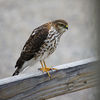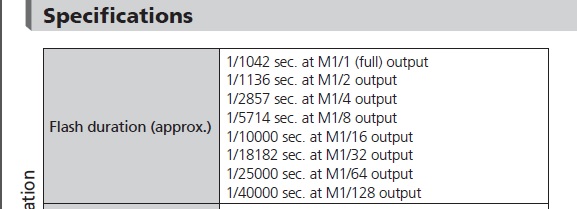A question about flash
Nov 3, 2017 21:36:06 #
My flashes have several power settings: Full, 1/2 1/4 and so forth all the way down to 1/124. Typically, how does a speed light control power usage? Do they Flash for a longer fraction of a second, or emit a more powerful, brighter light?
Nov 3, 2017 21:56:59 #
As I understand it, it is a bit of both. As you increase the power, more light is pushed out to make a stronger flash. But the time at peak power is also a bit longer.
One thing that people do to help freeze fast movement is to use the flash at a low power setting, increasing ISO and opening the aperture to compensate for the weaker flash.
One thing that people do to help freeze fast movement is to use the flash at a low power setting, increasing ISO and opening the aperture to compensate for the weaker flash.
Nov 3, 2017 22:03:35 #
Chefneil wrote:
My flashes have several power settings: Full, 1/2 1/4 and so forth all the way down to 1/124. Typically, how does a speed light control power usage? Do they Flash for a longer fraction of a second, or emit a more powerful, brighter light?
The speed does not change. What changes is the electric discharge that creates the flash.
How they do it? I am not an engineer. Voltage? Power (amp)? I have no clue.
Nov 3, 2017 22:30:32 #
Nov 3, 2017 22:33:34 #
I can’t swear this is true of all flashes/strobes, but my opinion is that when you’re changing the output, you’re changing the duration of the flash, not the light output. If you check the specs of a typical studio strobe, you’ll note that the duration decreases with a decrease in power setting.
Nov 3, 2017 22:40:34 #
This is a very basic explanation.
Flashes work by discharging a capacitor, which holds an electrical charge, through a zenon flash tube. The gas inside the tube emits photons as a result of the electrical discharge.
The more electrical energy that is allowed to pass through the tube, the more photons are emitted and the more light reaches the subject.
A thyristor is a high speed electrical switch. By inserting a thyristor in the circuit between the capacitor and flash tube, the flash output can be shut down when a sufficient number of photons have been output to achieve the percentage of desired output by triggering the thyristor to turn off.
I hope that gives you an idea of how they work and I hope it answers your question.
Flashes work by discharging a capacitor, which holds an electrical charge, through a zenon flash tube. The gas inside the tube emits photons as a result of the electrical discharge.
The more electrical energy that is allowed to pass through the tube, the more photons are emitted and the more light reaches the subject.
A thyristor is a high speed electrical switch. By inserting a thyristor in the circuit between the capacitor and flash tube, the flash output can be shut down when a sufficient number of photons have been output to achieve the percentage of desired output by triggering the thyristor to turn off.
I hope that gives you an idea of how they work and I hope it answers your question.
Nov 3, 2017 23:03:56 #
TriX wrote:
I can’t swear this is true of all flashes/strobes, but my opinion is that when you’re changing the output, you’re changing the duration of the flash, not the light output. If you check the specs of a typical studio strobe, you’ll note that the duration decreases with a decrease in power setting.
I agree. And this fits with the use of reduced power to freeze movement in macro and in freezing action such as the wings of hummingbirds
Nov 3, 2017 23:29:12 #
Rongnongno wrote:
The speed does not change. What changes is the electric discharge that creates the flash.
How they do it? I am not an engineer. Voltage? Power (amp)? I have no clue.
How they do it? I am not an engineer. Voltage? Power (amp)? I have no clue.
Sorry, but with most speedlights, flash duration varies with power output. A capacitor is fully charged, and the charge is released until the required level is reached and the discharge is cut off. For example, with a Nikon SB-700, flash duration is 1/40000 sec at 1/128 output, and is 1/1042 sec at full output (per the SB-700 user manual).
To freeze motion, several flashes can be used, each with lower power settings and thus shorter flash duration.
On the other hand, many strobes only charge the capacitors to the power needed, and fully discharge the capacitor when fired. That is why, after charging to a certain level, if you turn down the power on the strobe it will flash to dump charge from the capacitors. But some strobes do have fast discharge settings (such as my Einsteins).
Nov 4, 2017 06:38:48 #
Nov 4, 2017 06:46:56 #
Nov 4, 2017 08:05:58 #
The duration of flash is effected - as stated - to catch a hummingbird's wings you have to position a flash close by and set it on a low power setting wich will get the speed to 1/8000 or so. I was fortunate enough to take a college course from Harold "Doc" Edgerton in 1970.(doesn't make me an expert!) We designed and built strobes with speeds of 1/50,000 second which we used to photograph bullets in flight cutting playing cards in half, etc. . The very short flash was not very bright and these photos were taken in a darkened lab. That was using the very early transistors - nothing fancy... Even then he was retired, but the college cherished him so much that he was designated an "Institute Professor" who had no official responsibilities but could keep a lab, have graduate students, and teach classes. He was a gem of a person - he would have us overwhelmed freshmen students over for dinner with he and his wife - "simple folks from Nebraska".
Doc developed high-speed strobes and pioneered high-speed photography - many of his photos appearing in Life magazine. He also developed HUGE strobes for night-time aerial photography over Germany in WWII, and he invented the side-scanning sonar which helped find the Titanic - but he famously went with Michael Ballard looking for the Loch Ness monster with it.
He also designed lens systems for photographing down to 1/100,000 sec, with which he photographed the very fist open-air tests of hydrogen bombs.
Just wanted to give the man his due here! We owe him a lot.
See: http://edgerton-digital-collections.org/galleries/iconic
Doc developed high-speed strobes and pioneered high-speed photography - many of his photos appearing in Life magazine. He also developed HUGE strobes for night-time aerial photography over Germany in WWII, and he invented the side-scanning sonar which helped find the Titanic - but he famously went with Michael Ballard looking for the Loch Ness monster with it.
He also designed lens systems for photographing down to 1/100,000 sec, with which he photographed the very fist open-air tests of hydrogen bombs.
Just wanted to give the man his due here! We owe him a lot.
See: http://edgerton-digital-collections.org/galleries/iconic
Nov 4, 2017 09:26:14 #
Nov 4, 2017 12:42:24 #
Nov 4, 2017 14:50:03 #
CO wrote:
The flash duration varies. Here is a chart from my Nikon SB-700 flash manual.
Owners manual? What? Who? I actually seen that chart in my manual and never thought I would hear about in again. Not sure how to apply that information- but it is correct.
Nov 4, 2017 16:03:05 #
If you want to reply, then register here. Registration is free and your account is created instantly, so you can post right away.














